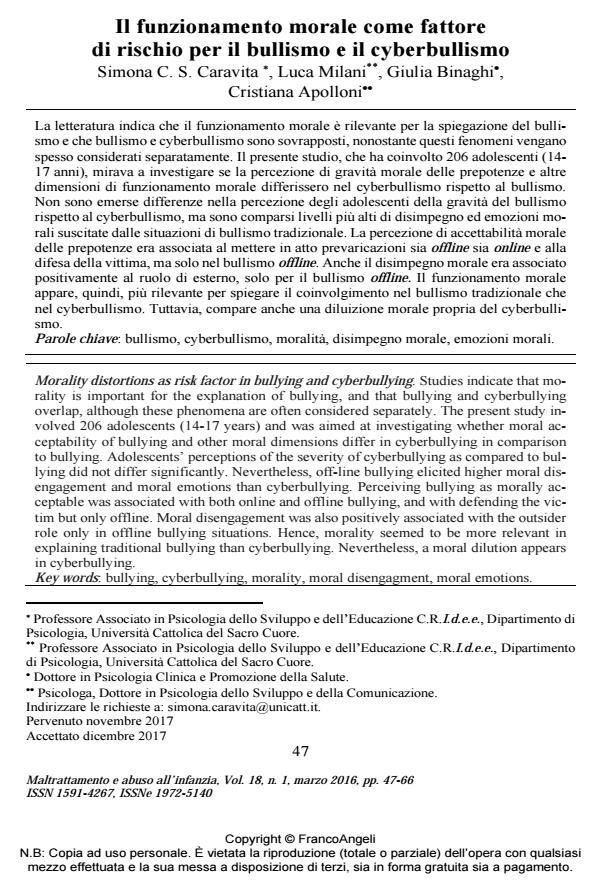Morality distortions as risk factor in bullying and cyberbullying.
Journal title MALTRATTAMENTO E ABUSO ALL’INFANZIA
Author/s Simona C. S. Caravita, Luca Milani, Giulia Binaghi, Cristiana Apolloni
Publishing Year 2018 Issue 2018/1
Language Italian Pages 20 P. 47-66 File size 262 KB
DOI 10.3280/MAL2018-001004
DOI is like a bar code for intellectual property: to have more infomation
click here
Below, you can see the article first page
If you want to buy this article in PDF format, you can do it, following the instructions to buy download credits

FrancoAngeli is member of Publishers International Linking Association, Inc (PILA), a not-for-profit association which run the CrossRef service enabling links to and from online scholarly content.
Studies indicate that morality is important for the explanation of bullying, and that bullying and cyberbullying overlap, although these phenomena are often considered separately. The present study involved 206 adolescents (14-17 years) and was aimed at investigating whether moral acceptability of bullying and other moral dimensions differ in cyberbullying in comparison to bullying. Adolescents’ perceptions of the severity of cyberbullying as compared to bullying did not differ significantly. Nevertheless, off-line bullying elicited higher moral disengagement and moral emotions than cyberbullying. Perceiving bullying as morally acceptable was associated with both online and offline bullying, and with defending the victim but only offline. Moral disengagement was also positively associated with the outsider role only in offline bullying situations. Hence, morality seemed to be more relevant in explaining traditional bullying than cyberbullying. Nevertheless, a moral dilution appears in cyberbullying.
Keywords: Bullying, cyberbullying, morality, moral disengagment, moral emotions
- Focus Monotematico: Il Cyberbullismo come emergenza sociale: indicazioni per l'intervento alla luce della nuova normativa Maria Assunta Zanetti, Simona C. S. Caravita, in MALTRATTAMENTO E ABUSO ALL'INFANZIA 1/2018 pp.7
DOI: 10.3280/MAL2018-001001
Simona C. S. Caravita, Luca Milani, Giulia Binaghi, Cristiana Apolloni, Il funzionamento morale come fattore di rischio per il bullismo e il cyberbullismo in "MALTRATTAMENTO E ABUSO ALL’INFANZIA" 1/2018, pp 47-66, DOI: 10.3280/MAL2018-001004